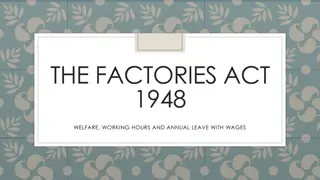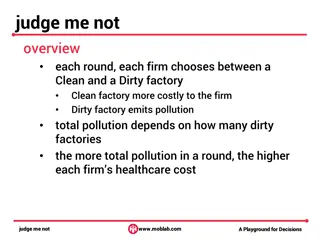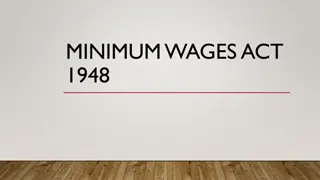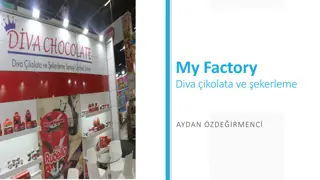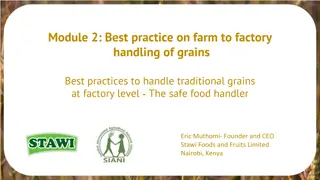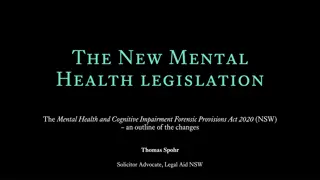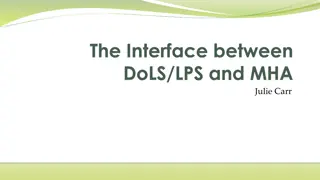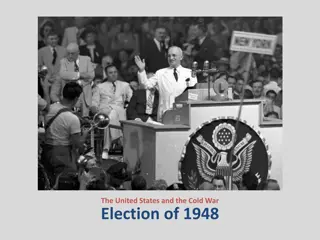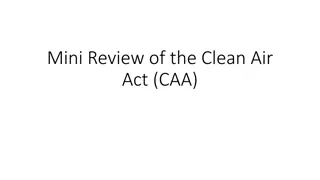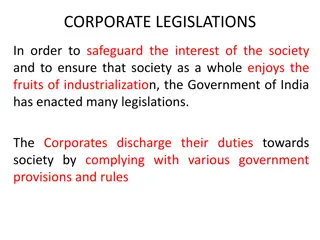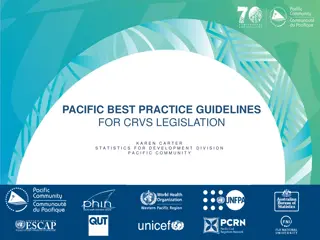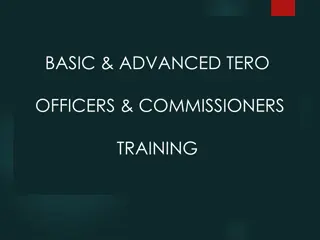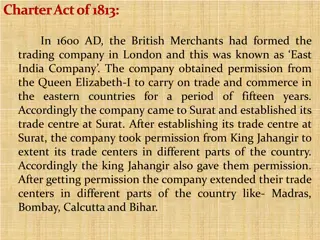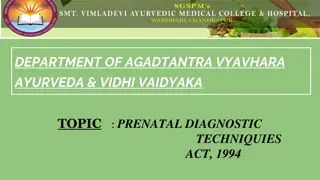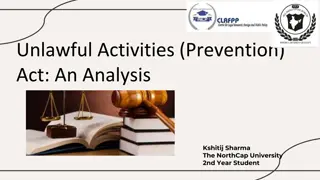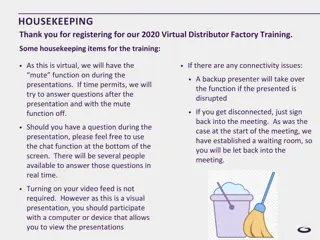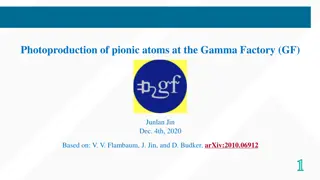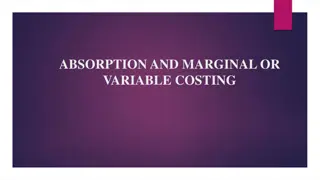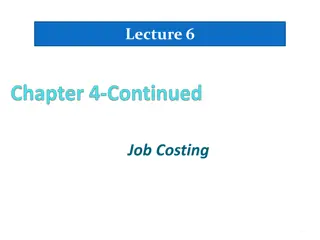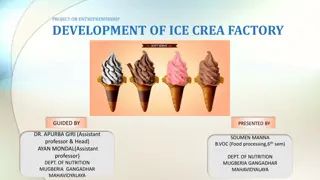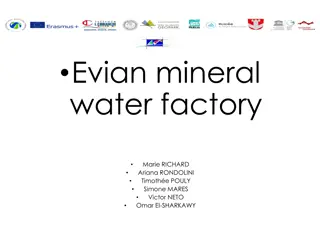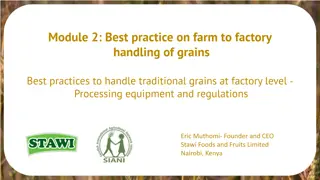Evolution of Factory Legislation in India: Factories Act, 1948 Overview
Explore the evolution of factory legislation in India through the lens of the Factories Act, 1948. Delve into historical developments, objectives, scope, and provisions regarding health, safety, welfare, working hours, holidays, leave, and special considerations for women and young workers. Understand the administrative setup and enforcement mechanisms upheld by this pivotal legislation.
Download Presentation

Please find below an Image/Link to download the presentation.
The content on the website is provided AS IS for your information and personal use only. It may not be sold, licensed, or shared on other websites without obtaining consent from the author. Download presentation by click this link. If you encounter any issues during the download, it is possible that the publisher has removed the file from their server.
E N D
Presentation Transcript
Objectives To know the objectives, scope and coverage of the Act To take note of the provisions relating to health, safety and welfare To understand the provisions relating to working hours, holidays and leave To develop an understanding about the special provisions for women and young persons To appreciate the administrative and enforcement machinery.
Structure Historical Development of Factory Legislation Object of the Act Scope and Applicability of the Act Definitions Approval, Licencing and Registration of Factories
The Inspecting Staff Certifying Surgeons Health Safety Provisions Relating to Hazardous Processes. Welfare of Workers Working Hours of Adult Workers Employment of Young Persons Annual Leave with Wages Other Features
HISTORICAL DEVELOPMENT OF FACTORY LEGISLATION Cotton Mills in 1851, and a Jute Mill in Bengal in 1855,ushered in modern factory system in India. Women ,children employed. long hours of workers used to have their way. Indian Factories Act 1881: protection to employees& children. The Factory Commission, 1890 recommendations of the Commission an Act was passed in 1891, Factory defined as fifty persons or more were employed. Amended in The Act of 1911 & 1922
Convention of 1919 on Hours of Work: amendment in 1923/26 The Act was revised/ redrafted in 1934 on recommendations by the Royal Commission on Labour, 1929. Act, 1934, Provincial Government empowered to establishments using power employing more than ten, reduced hours of work, improve the working condition ; inspection and enforcement of the Act. Amended several times before new Act of 1948 was passed.
Act,1948 Factories Act, 1934 revised 1948: scope extended to welfare, health, cleanliness, overtime safe and healthy working conditions in the factories, bodily strain and without fear and danger of accidents. Amended periodically up to 1976. Chemical factories , hazardous and toxic chemicals led to safety and health problems, Bhopal In 1987, Factories (Amendment) Act, 1987 was passed, a memorial to the victims of Bhopal. provides better safeguards in the use and handling of hazardous substance , management for greater safety measures
Act,1987 Portable electric light in the factories), Safety officers :1000 or more workers ,risk of bodily injury, poisoning ,disease, health hazard investigations of all fatal accidents within a month Safety and occupational health surveys. Chief Inspector / Director General of Factory Advice Service / Labour Institutes / DGHS Protection for contract labour &other category of labour Creche facility: more than 30 women workers (instead of 50) Discharge /dismissal/superannuation/death in service; wages in lieu of the quantum of leave due. Penalty: Rates modified & revised.
OBJECT OF THE ACT To protect human beings from being subject to unduly long hours of bodily strain or manual labour. It also seeks to provide that employees should work in healthy and sanitary conditions so far as the manufacturing process will allow and that precautions should be taken for their safety and for the prevention of accidents.
SCOPE AND APPLICABILITY Extends to whole of India. Applies to all factories including factories belonging to Central or any State Government unless excluded. The benefits available to persons who are employed in the factory and be covered within the meaning of the term "worker . "factory" "manufacturing process
DEFINITIONS: Factory Section 2: any premises i) where on ten or more workers are working, or were working on any day of the preceding twelve months, and in any part of which a manufacturing process is being carried on with the aid of power, or is ordinarily so carried on. ii) where on, twenty or more workers are working, or were working on any day of the preceding twelve months, and in any part of which a manufacturing process is being carried on without the aid of power, or is ordinarily so carried on. Specifically excludes Mines
Manufacturing Process Sec 2(k) i) making, altering, repairing, ornamenting, finishing, packing, oiling, washing, cleaning, breaking up, demolishing, or otherwise treating or adapting any article or substance with a view to its use, sale, transport, delivery or disposal; or ii) pumping oil, water, sewage, or any other substance; or iii) generating, transforming or transmitting power; or iv) composing types for printing, printing by letter press, lithography, or other similar process or book binding; or v) constructing, reconstructing, refitting, finishing or breaking up ships or vessels; or vi) preserving or storing any article in cold storage.
Worker: Sec2(1) A person employed, directly or through any agency (including a contractor) with or without knowledge of principal employer, whether for remuneration or not, in any manufacturing process, or in cleaning any part of the machinery or premises used for a manufacturing process or in any other kind of work incidental to, or connected with, the manufacturing process, or the subject of the manufacturing process but does not include any member of the armed forces of the Union
Worker: Interpretation i) who is employed; ii) who is employed either directly or through any agency; iii) who is employed in any manufacturing process, or in clearing any part of the machinery or premises used for a manufacturing process or in any other kind of work incidental to, or connected with the manufacturing process or the subject of the manufacturing process. If the aforesaid conditions are satisfied, then it is immaterial whether a person was employed for remuneration or not.
General Duties of the Occupier Section 7A has been inserted by the Factories (Amendment) Act 1. Plant maintenance that is safe and without risk to health of workers. 2. Safeguard health and safety with the use, handling, storage and transport of articles and substance. 3. Provide information, instruction, training and supervision to ensure health and safety of all workers. 4. Monitoring of work environment. To prepare written statements of policy with respect to the health and safety of workers and to give notice to the workers as per rules. General duties of manufacturers etc. as regards articles and substances for use
Approval,Licencing & Registration of Factories Responsibility for getting the premises approved lies on the occupier. State Government to frame rules (Sec-6) Can declare departments /branches of a factory as separate factories, if requested by the occupier. Sec4 But there is no provision to enable two or more factories of the same occupier being declared as a single factory. Can exempt any factory or class from provisions of the Act (except section 67) for a specified period in case of public emergency, which means grave emergency for 3 months at a time.
To be got approved and registered after obtaining a licence by the occupier Occupier for submission of plans to the Chief Inspector & obtain previous permission with regard to site for constructed/ extension, in minimum clear space for safe working around plant machinery adversely affects the environmental conditions from the evolution or emission of steam, heat or dust or fames injurious to health. Occupier to submit full building plans along with specifications The registration, obtaining of licence or renewal of licence, is to be done by the occupier in accordance with the rule by paying the prescribed fees.
The permission be given within 3 months or presumed. If refused, appeal to the State or Central Government No license or renewal of license shall be granted unless the occupier gives at least 15 days notice in writing to the Chief Inspector of factories before he proposes to occupy or use any premises as factory. Such notice shall state following particulars of factory, i) the name and situation of the factory; ii) the name and address of the occupier; iii) the name and address of the owner of the premises or building
the nature of manufacturing process; v) the total rated horse power installed or to be installed in the factory, which shall not include the rated horse power of any separate standby plant; vi) The name of manager of the factory for the purpose of this Act; vii) The number of workers likely to be employed in the factory ; viii) the average number of workers per day employed during the last twelve months, in case of a factory, is in existence on the date of the commencement of this Act; ix) such other particulars as may be prescribed under the rules. [Section 7 (1)] For manufacturing: 30 days notice [Section 7 (2)].
The occupier to give notice to the Chief Inspector with above particulars for already existing factories within 30 days [Sec7 (2)]. For factories engaged in manufacturing process for less than 180 working days a year resumes working, the occupier to send full particulars within 30 days of such resumption of work [Sec 7 (3)]. To intimate change in appointment of manager within 7 days [Sect7 (4)]. During the time no manager functions in the factory, the occupier is deemed as manager. Non compliance: an offence, occupier can be punished. Sec 6 & 7
THE INSPECTING STAFF i) Appointment State Government to appoint Inspectors by notification. Six types. (i) Chief Inspector (ii) Additional Chief Inspectors, (iii) Joint Chief Inspectors (iv) Deputy Chief inspectors (v) Inspectors and Additional Inspectors. In addition to the powers of a Chief Inspector all above can exercise the powers of an Inspector throughout the State. No person to become directly or indirectly interested in a factory Every district Magistrate shall be an Inspector for his district. State Government to appoint-public officers as additional Inspectors
Inspectors. ii) Status Every inspector be deemed public servant under IPC, officially subordinate to specified authority . iii) Power of Inspectors (Sec9) enter any premises with assistants, local public authority, expert ; make examination of the premises, plant, machinery, article or substance; inquire into any accident, dangerous occurrence, whether resulting in bodily injury, disability or not, and take statements of any person Require production of any prescribed register/other document seize, or take copies of an register, record or other document.
Inspectors. Direct occupier that premises be left undisturbed for examination take measurements and photographs /recordings for examination under clause (b), with instrument or equipment; Direct dismantlement or subject to process/ test found in any premises, being an article or substance which appears to him as having caused or is likely to cause danger to the health or safety of the workers, to damage or destroy it and take possession of any such article or substance and detain it for such examination; exercise such other power as may be prescribed.
Duties of the Inspectors The Inspectors are required: i) to carry out duties laid down: Sec9 (b)& (c); ii) to ensure that statutory provisions and rules framed are carried out properly; and iii) to launch prosecutions against factoryowners under Chapter X of the Act.
HEALTH MEASURES(SEC-11 TO 20) i) Cleanliness Dust, fumes and refuse be removed daily; floors, stair-cases and passages be cleaned regularly by sweeping; washing of interior walls and roofs at least once in 14 months ; washable water paint, repainted every three years and for oil paint at least once in five years. All doors and window frames and other wooden or metallic framework and shutters be kept painted or varnished at least once in five years. Sec11 ii) Disposal of Wastes and Effluents (SEC-12) Owner to make effective arrangements for the treatment of wastes and effluents to render them innocuous and for their disposal. iii) Ventilation and Temperature (SEC-13) The occupier to make adequate ventilation of fresh air and to maintain such temperature as will secure to workers reasonable conditions of comfort and prevent injury to health.
HEALTH iv) Dust and Fume To keep the workrooms free from dust and fume, prevent its inhalation and accumulation in any work-room. If any exhaust appliance is necessary for the above purposes, it shall be applied as near as possible to the point of origin of the dust, fume or other impurity and such point shall be enclosed as far as possible. Sec14(1) v) Artificial Humidification Section 15 (1) lays down that in respect off all factories in which the humidity of the air is artificially increased the State Government may make rules- prescribing standard of humidification; regulating the methods used for artificially increasing the humidity of the air; directing prescribed tests for determining the humidity of the air to be correctly carried out and recorded; prescribing methods to be adopted for securing adequate ventilation and cooling of the air in the workroom.
HEALTH Overcrowding No room be to be injurious. Each worker to have minimum 9.9 cubic meters which was there on the commencement of this Act, 1948 or 4.2 cubic meters after such commencement (Section 16). No account shall however be taken of any space which is more than 4.2 meters above the level of the floor of the room for the aforesaid purpose, (a) (b) (c) (d) Law on Working vii) Lighting Section 17 (1) provides that in every part of the factory, where workers are working or passing, there shall be provided and maintained sufficient and suitable lighting, natural, artificial or both.
HEALTH.. viii) Drinking Water To provide and maintain at suitable conveniently situated a sufficient supply of wholesome drinking water.Sec18 ix) Conservancy Arrangements provided and' maintained, separate arrangement for toilets for male and female workers at convenient places; adequately lighted, ventilated and maintained in a clean sanitary condition. Sec19 x) Spittoons Sufficient spittoons in convenient places in a clean and hygienic condition. Sec20
SAFETY MEASURES i) Fencing of Machinery sec21(1) The following must be securely fenced by safe guards of substantial construction while the machinery are in motion or use : i) every moving part of a prime mover and fly wheel connected to prime mover, ii) the headrace and tailrace of every water-wheel and water turbine; iii) any part of stock-bar which projects beyond the head stock of a lathe; and iv) unless they were securely fenced, the following, namely, every part of electric generator, a motor or rotary converter; every part of transmission machinery; and every dangerous part of any other machinery; shall be securely fenced by safeguards of substantial construction which shall be consistently maintained and kept in position while the parts of machinery they are fencing are in motion or in use.
Work on or Near Machinery in Motion Examine machinery and to carry out: Sec22(1) lubrication or other adjusting operation; or any mounting or shipping of belts or lubrication . By specially trained Adult male worker wearing tight-fitting clothing a) such worker shall not handle a belt at a moving pulley unless: i) the belt is not more than fifteen centimeters in width; ii) the pulley is normally for the purpose of drive; iii) the belt joint is either laced or flush with the belt; iv) the belt, the joint and the pulley rim, are in good repair; v) reasonable clearance between the pulley & fixed plant vi) secure foothold & handhold, provided for the operator; vii) any ladder securely fixed/ lashed/ firmly held b) Every set screw, bolt and key on any revolving shaft, spindle, wheel, pinion, gearing in motion securely fenced .
iii) Employment of Young Person on Dangerous Machine Prohibits employment of young person on dangerous machine unless fully instructed on dangers /precautions and (i) received sufficient training in work at the machine, or (ii) is under adequate supervision by a person who has a thorough knowledge and experience of the machine. Sec23 Other safety provisions iv) Striking Gear and Devices for Cutting off Power v) Self-acting Machines Section 25 vi) Casing of New Machinery Section 26 punishable with imprisonment for a term which may-extend to three months or with fine which may extend to Rs 500 or with both. vii) Prohibition of Employment of Women and Children near Cotton Openers (Section 27). viii) Roust and Lifts Section 28:hoists and lifts must be of good mechanical construction, sound material and adequate strength. not 'only be properly maintained but also thoroughly examined at least twice a year by competent persons. ix) Revolving Machinery Sec30
xi) Pits, Sump and Opening in Floors xii) Precautions Against Dangerous Fumes, and Gases entry in any chamber, tank, vat, pit, pipe, flue, or other confined space in any factory in which any gas, fume, vapor or dust is likely to be present, until all practicable measures have been xiii) Precaution Against Using Portable Electric Light. Prohibits on use of portable electric light or any other electric appliance of voltage exceeding 24 volts xiv) Explosive or Inflammable Materials These measures include : (i) effective enclosures of the plant or machinery used in the process; (ii) removal or prevention of the accumulation of such dust, gas or vapor; (iii) exclusion or effective enclosure of all possible sources of ignition. [Section 37 (i)].
Precaution in Case of Fire xvi) Safety of Building and Machinery xvii) Maintenance of Buildings xviii) Safety Officers In order to prevent accidents, the Act provides for the appointment of Safety Officers in factories employing 1,000 or more workers or where any manufacturing process or operation is carried on, which process or operation involves any risk of bodily injury, poisoning or disease, or any other hazard to health, to the persons employed in the factory. (Section 40-B).
PROVISIONS RELATING TO HAZARDOUS PROCESSES Section 2 (cb) of the Factories (Amendment) Act, 1987 defines the term "hazardous process" as any process or activity in relation to an industry specified in the First Schedule where, unless special care is taken, raw materials used therein or the intermediate or finished products, bye- products, wastes or effluents thereof would : i) cause material impairment to the health of the persons engaged, ii) result in the pollution of the general environment Provided that the State Government may, by notification in the Official Gazette, amend the First Schedule by way of addition, omission or variation of any industry.
Initial location involving hazardous process or expansion a Site Appraisal committee consisting of- Law on Working 22 Conditions (a) (b) (c) (d) (e) (f) (g) (h) 1). 2). 3). 4). 5). the Chief Inspector of the State who shall be its Chairman, a representative of the Central Board for the Prevention and Control of Water Pollution appointed by the Central Government under Section 3 of the Water (Prevention and Control of Pollution) Act, 1974; a representative of the Central Board for the Prevention and Control of Air Pollution referred to in Section 3 of the Air (Prevention and control of Pollution) Act, 1981; a representative of the State Board appointed under Section 4 of the Water (Prevention and Control of Pollution) Act, 1974; a representative of the Central Board for the Prevention and control of Air Pollution referred to in Section 5 of the Air (Prevention and Control of Pollution) Act, 1981; a representative of the Department of Environment in the State; a representative of the Meteorological Department of the Government of India;
i) a scientist having specialized knowledge of the hazardous process which will be involved an expert in the field of occupational health; and a representative of Town Planning Department of the State Government ii) a representative of the local authority within whose jurisdiction iii) not more than three other persons by the State Government. Site Appraisal Committee shall examine application for establishment factory owned or controlled by the Central Government: State Government co-opt in Site Appraisal Committee a central govt representative The State Appraisal committee shall have power to call for any information involving a hazardous process. Where the State Government has granted approval involving a hazardous process, further approval from the Central Board not necessaryvention and Pollution) Act, 1981.
Compulsory disclosure of information by the occupier The occupier to disclose dangers, health hazards and the measures to overcome them arising from the exposure to or handling of the materials or substances in the manufacture, transportation, storage and other processes to : (i) Workers employed in the factory (ii) the Chief Inspector, (iii) the local authority within whose jurisdiction the factory is situated and (iv) general public in the vicinity. While registering the factory involving a hazardous process, the occupier shall lay down a detailed policy with respect to the health and safety of the workers-and intimate such policy to the Chief Inspector Such information, shall include accurate quantity, specifications and other characteristics of wastes and manner of their disposal (Sub-section 3).
Every occupier to draw up an on site emergency plan and detailed disaster control measures for his factory and make known to the workers employed therein and to the general, 4 public living in the vicinity of the factory the safety measures required to be taken the event of an accident taking place. [Sub-section 4] to inform the Chief Inspector of the nature and details of the process On contravention of provisions of sub-section (5), the licence issued be cancelled and the occupier liable to penalty (Sub-section 6). 7). The occupier of the factory involving a hazardous process shall, with the previous approval of the Chief Inspector, lay down measures for the handling, usage, transportation and storage &disposal of hazardous substances and publicize them in the prescribed manner among the workers and the general public living in the vicinity (Sub- section 7).


